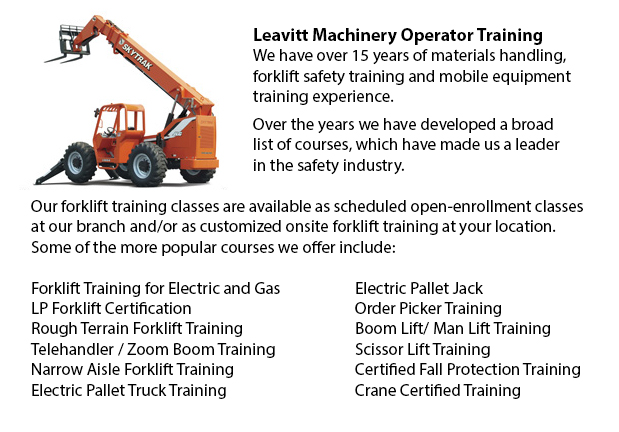
Zoom Boom Training Tukwila - Zoom Boom Training is intended to train operators on variable reach forklifts. The objectives of the training are to impart an understanding of the physics of the equipment, and to outline the operator's job. This course follows North American safety standards for lift trucks. Zoom boom training and certification is available at the company's location or at our site, provided there are a minimum number of people training. Certification received upon successful completion is valid for three years.
A telescopic handler (also called a telehandler) is similar in some ways to both a crane and a forklift. It is a helpful equipment designed with a telescopic boom which can extend forwards and lift upwards. Various attachments can be fitted on the end of the boom, such as pallet forks, bucket, lift table or muck grab. It is popular in agriculture and industry settings.
Telehandlers are most normally utilized along with the fork attachment in order to shuttle loads. The units have the advantage that they could reach places inaccessible to standard forklifts. Telehandlers are capable of removing loads that are palletized from within a trailer and placing them on places which are high such as rooftops. For certain applications, they could be more practical and efficient than a crane.
The disadvantage of the telehandler is its unsteadiness when lifting loads that are heavier. When the boom extends with a load, the unit becomes ever more unstable. Counterweights in the rear help, but don't solve the problem. When the working radius increases, the lifting capacity quickly decreases. Various equipment come along with front outriggers that extend the lifting capacity when the machinery is stationary.
A load chart helps the operator to know whether a given load is too heavy. Factors like for example boom angle and height and load weight are calculated. Several telehandlers have sensors that cut off further control or provide a warning if the unit is in danger of destabilizing.
-
Forklift Train The Trainer Tukwila
Forklift Train The Trainer Tukwila - We provide amongst the best Forklift Training programs within North America, using the latest and most advanced training techniques. Amongst our training courses are Train the Trainer courses, mobile equipment ope... More -
Crane Certification Tukwila
Crane Certification Tukwila - The Crane Certification training program covers content suggested by industry concerning the safe and efficient operation of cranes. People training will learn the following: pre-operational, operational and post operati... More -
Manlift Safety Training Tukwila
Manlift Safety Training Tukwila - It is vital for competent Manlift operators to be aware of the associated dangers which come with specific types of scissor lifts. They need to be able to operate the scissor lift in a way which protects not just the... More -
Scissor Lift Training Tukwila
Scissor Lift Training Tukwila - While operating a scissor lift, they must be utilized proficiently so as to protect the safety of the other personnel in the workplace and to protect the safety of the machine. Skilled operators are trained to drive th... More -
Crane Operator Certification Tukwila
Crane Operator Certification Tukwila - Crane Operator Certification is a process which permits people to earn a certificate to operate certain kinds of cranes. Certification includes classroom learning, hands-on practice and an ability evaluation. Se... More -
Forklift Operator Certification Tukwila
Forklift Operator Certification Tukwila - Certification for forklifts are required to guarantee the safe utilization of forklifts for those employers in construction, industrial and warehouse environments. The training has to include a method of educ... More -
Boom Lift Ticket Tukwila
Boom Lift Ticket Tukwila - Boom Lifts are a platform lift apparatus which can be raised or lowered to differing heights, making this apparatus a useful tool for various manufacturing uses. There are many distinctive types of Boom Lift consisting of k... More -
Bucket Truck Training Tukwila
Bucket Truck Training Tukwila - The bucket truck training program is a program that is designed to efficiently train qualified operators so they could lessen the chance of personal injury and incident when working in close proximity to or with bucket... More

Forklift Training Tukwila
TOLL FREE: 1-888-254-6157
Tukwila, Washington
forklifttrainingtukwila.com
Email Us
About Us


